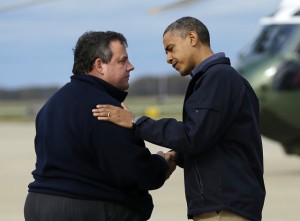
President Barack Obama is greeted by New Jersey Governor Chris Christie upon his arrival at Atlantic City International Airport yesterday. (AP Photo/Pablo Martinez Monsivais)
As many up and down the Eastern seaboard continue to deal with Hurricane Sandy’s aftermath, Boards of Elections in mid-Atlantic states are scrambling to make sure those who want to vote can, regardless of the condition in which the storm left their communities. Yesterday, the Gotham Gazette spoke with John Conklin, spokesman for the New York State Board of Election.
“The local boards impacted by the storm are assessing damage to the polling places right now,” Conklin said. “We have been in meetings with the governor’s office and local boards to work on these assessments. We have to see if power still remains at the polling site, if they remain accessible to the public, the board and the machines. We also need to make sure the sites are safe. Once that is done, we will check on alternate polling sites and make sure they have tents, generators and whatever else they need.”
“I hope turnout is not siginificantly impacted,” said Conklin, adding that “some people’s homes also were burned down, some are under water and voting is not their biggest concern … But we want to make sure that when they choose to vote that they have a place to do it.”
Ian Inaba is the co-executive director of the Citizen Engagement Laboratory, the group that organizes the citizen journalism project Video the Vote to document voter disenfranchisement. Inaba said the storm will create further barriers to voting for the communities hit hardest.
“Prior to the storm, we were expecting voters to encounter issues ranging from long lines, new voter ID requirements, machine malfunctions and possible poll challengers,” he said. “Now we are looking at a whole new set of challenges. Will power be restored in time? Have machines been damaged? Will polling locations need be moved? Sadly, we know some residents will still be displaced or simply have other pressing recovery issues that will interfere with the exercising of their right to vote.”
Inaba said Video the Vote will be working to document the experiences of communities affected by the storm in addition to other forms of disenfranchisement. The Albany Times-Union reported that under New York state law, a county or state board of elections could call a second vote if less than 25 percent of registered voters show up due to “a fire, earthquake, tornado, explosion, power failure, act of sabotage, enemy attack or other disaster.”
Dennis Kobitz, president of the New Jersey Association of Election Officials, told CNN that he’d like to try and keep “one or two polling places open in each town” … but right now, he’s not sure that is realistic.
“Our biggest problem at this point is getting the machines to the polling places. Nobody’s there to accept the machines,” Kobitz said, noting that many of them are locked and without power.
“Do I leave [the polling machines at the polling stations]?” Kobitz asked, frustrated with the unknown. “How do I take a chance that the schools will have power?”
Along the New Jersey shoreline, some polling places on the barrier islands will be unable to open and voters will have to come inland to cast their ballots. The state GOP chairman George Gilmore said he is pushing hard for provisional ballots in every town — “That way anybody can go to the closest polling places if they’ve been displaced and won’t have to worry about driving all over the place,” he told PolitikerNJ. Gilmore also said that, because it is a federal election, New Jersey could not postpone the election even if they wanted to.
New York and New Jersey, the two states most impacted by Sandy, are solidly polling for Obama. But Pennsylvania, a swing state, may also face difficulties getting its polls open. The Washington Post reports that Philadelphia, an Obama stronghold, weathered the storm fairly well, but the Associated Press reports that it is possible (but not likely) that some voting precincts will still be without power Tuesday.

